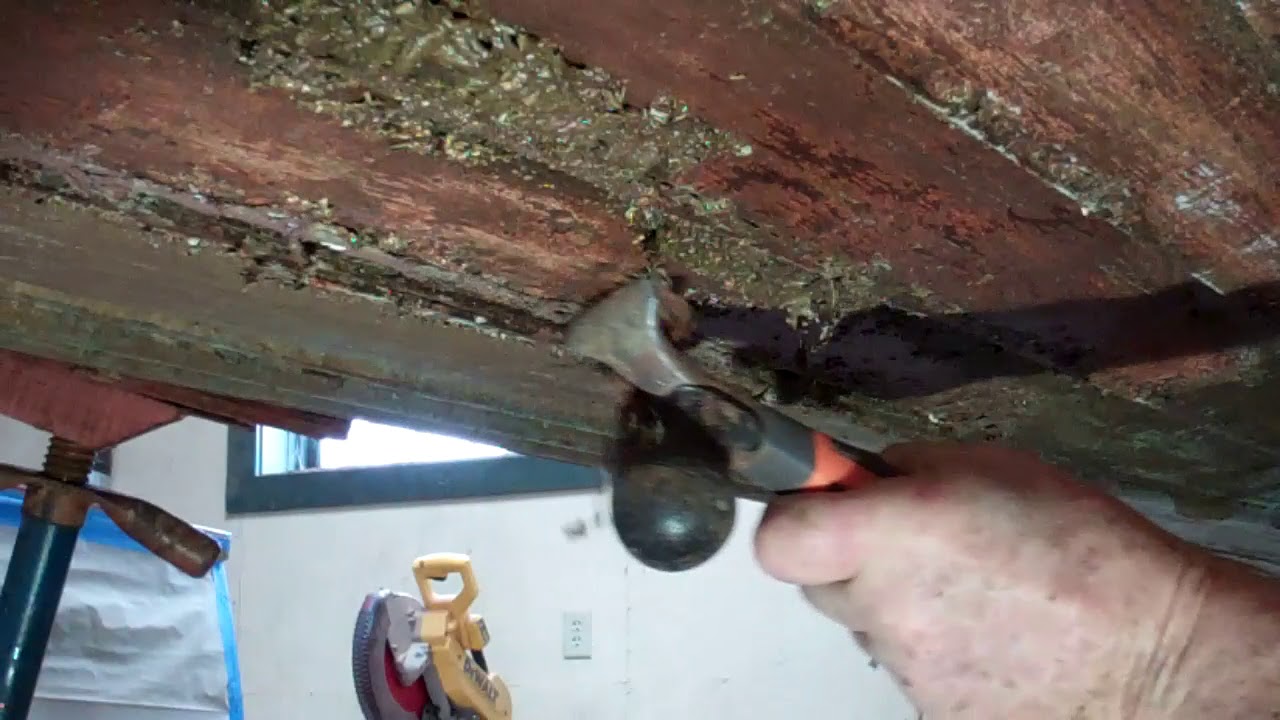After raising her five feet above the floor, RJ and I have been fully enjoying applying copious amounts of Circa 1850 Heavy Body Stripper – three coats in each area at a time before we begin removing what appears to be five to six coats of tired bottom paint between her boot strip and keel. The bottom planking is tight and the wood is in excellent shape, at least over the forward half of the bottom.
Our real disappointment erupted as soon as I began stripping the port garboard along the seam between it and the keel. The corner of my scraper blade caught the caulk payed into the seam and released about six feet of completely free material.
No, it was not 3M 5200. We found that imbedded all along the starboard garboard-keel seam. I’ve dealt with enough of this stuff bedding hardware on my sailboat. Boatlife Caulk it was. Adhered in any way to the wood anywhere it was not. A bit of tugging and long strings of this stuff literally just fell away.
That most of it exhibited a shiny, slick surface tells us that it most likely never adhered to the adjoining wood at all.
The seam is as much as a strong 7/16-inch wide in some places, and 3/8-inch wide along most of this distance. Properly addressing such seams is straightforward and involves first caulking them with cotton roving, which is then primed before paying the chosen caulking material begins.
All of that said, this experience, along with the arrival of this month’s issue of Practical Sailor and a heads up about a Wooden Boat Forum discussion on sealants got me to thinking.
While I am still researching, I believe there is value to you in sharing some of what I have learned to date.
Interlux Seam Compound v. Slick Seam Compound
Albeit twelve years ago, The Wooden Boat Forum hosted what can only be described as impassioned exchange.
One contribution reporting that heating, and then thinning the Interlux product with mineral spirits results in a consistency that “trowels out like butter.”
“…trick I used to use with any brand is to get a hot plate and put the can in a shallow pan of water and keep it hot, goes in the seams like butter, deeper, cleans up easy, and stiffens back as it cools…saves the fingers, hands, and wrists…and makes the bottom go quicker…..and another plus is in the cleaning process when you knife off the excess flush, and then wipe with your cleaner soaked rag, you get a concave seam, which allows for a smoother look after the boards have swelled…….”
And then there were several experienced-base observations that in cold climates where she must live on the hard for six months annually and dries out as a result, the Interlux Seam Sealer tends to become brittle and break away from the wood.
Bottom line: Slick Seam adheres tenaciously and handles the swell-shrink cycle well, but its waxy consistency presents offsetting issues that may outweigh its adherence advantage.
Interlux Seam Compound when heated and even thinned, applies easily, but may tend to lose adhesion during the annual swell-shrink cycles our woodies must endure.
Practical Sailor Magazine, March 2019 Issue – Sealant Testing Results
We tested a field of leading sealants including 3M 5200, 3M 4200 Fast Cure, 3M 4000 UV, Sika 291, Sika 295,Loctite PL S-40, Loctite PL Marine, Boat Life Caulk, Boat Life Seal, and Sudbury Elastomeric Sealant, for three years…. 3M 5200 Intended as a permanent bonding adhesive, not a sealant or bedding agent, 5200’s increased stiffness worked against it in the flexibility test. It took more than twice as much force to flex the samples, despite the fact that 5200 is thin and only about 50 percent as much material was present in the joint. To our surprise, 3M 5200 began losing bond strength by the third year. Bottom line: Recommended as an adhesive, but not as a flexible sealant.
SIKAFLEX 291
Sika 291 is Practical Sailor’s best buy of this group. “…(it) delivers more consistent bonding on a wider variety of materials. It came clean easier than most (of its competitors) and retained flexibility. Bottom line: A best choice for most applications. Missing in the results is any mention of Sika’s bonding to wood below the waterline.
BOATLIFE CAULK
This sealant failed to bond effectively in our shear testing, and it failed the flexibility testing completely, debonding completely the first time samples were bent. While you may like a sealant that is easy to remove, we think bond failure is never acceptable. Bottom line: Not acceptable.

